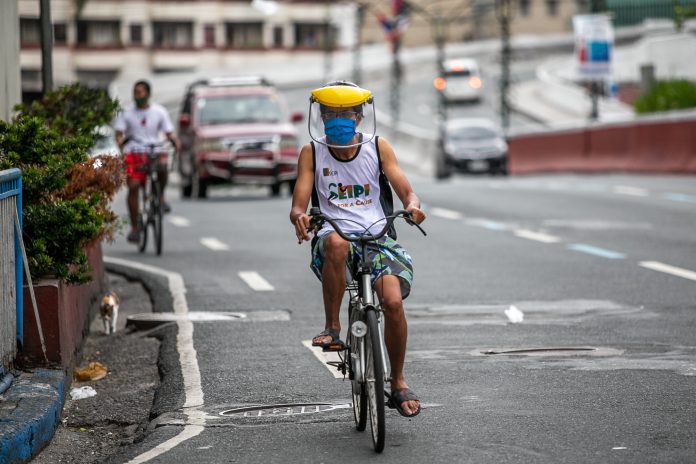IT’S World Bicycle Day in the midst of a pandemic that forces people to walk, or bike, to work because of the absence of public transport.
In the Philippines, however, authorities are removing temporary bike lane protectors placed by volunteer groups, saying these are illegal.
The group placed the road markers to set apart one lane of the highway in the capital for bikers after more people were observed to have taken their bicycles to work.
Before the lockdown due to the pandemic, Roggie Sarmiento, a 39-year old crew of a gas station in Manila, goes to work every day on his bicycle for at least two hours.
When authorities imposed the lockdown and restricted the movement of people and vehicles, Roggie’s travel to work took only 30 minutes.
“The road was friendly to bikers during the lockdwon,” he said. “I can ride in the middle of the highway because there are no other vehicles,” he said.
During normal days, bikers have no space on the road. “You cannot take the sidewalk because it is for people, or in our case, for vendors,” he said.
Sarmiento also noted that Filipino drivers are impatient “and they hate bikers.”
“If you’re in front of them, they will blow the horn or shout at you,” he said.
Sarmiento said he never had an accident but said there were times that he was nearly hit by fast-moving cars.

There were 957,348 road crashes recorded in Metro Manila from 2005 to 2016. About 15,056 of the total number involved bicycles and killed at least 250 people.
In 2019, The World Health Organization estimated that more than 40,000 cyclists died due to road crashes around the world.
Urban planner Franco Vistan told LiCAS.news that the Philippines’ road design is one of the reasons Filipino cyclists are vulnerable on the road.
“Majority of our roads, if not all, are designed with primary consideration to motor vehicles. There is no enough provision for pedestrians and cyclists,” he said.
Vistan said the few segregated bike lanes in the country are often too narrow.
He said many Filipinos also do not respect provisions for pedestrians and cyclists. “Oftentimes, people put obstructions on these provisions or we use them as parking spaces.”
Sidewalks for pedestrians are also based on minimum standards. “There are too many obstructions along the walkways that force people to walk on carriageways,” he said.
Provisions for cyclists and pedestrians are also not proportionate to the volume of users.
From May 16 to 30, the group Bikers United Marshalls monitored the number of bikers who pass through Commonwealth Avenue in the capital’s Quezon City.
The group recorded an average of 14 bikers per minute on the southbound lane and 11 bikers per minute on the northbound lane between 5:30 and 8:00 in the morning.
That was equivalent to 3,020 bikers during the morning rush hours alone.
The group also noted that many of the bikers were riding “counterflow” of vehicular traffic.
On June 1, the first day of the capital’s transition to a more relaxed quarantine protocol, the group recorded an average of more than 4,000 bikers.
Commonwealth Avenue, however, has no permanent provision for bike lanes, which means cyclists ride along on the same lanes that motorized vehicles use.
Vistan said it is “not easy to redesign the roads,” especially if they are being used in full capacity. “It’s not a matter of fixing a few roads and just building a project,” he said.

“The government has to address the problem in a comprehensive manner,” said Vistan, adding that making roads safe for all users will require careful study and planning.
“It is important to know people’s perception of road conditions to identify what are the real issues and to properly design the project,” he said.
“The solution here should be long-term,” he said. “The project can be done in a short period of time but may not be effective immediately,” he added.
Some local governments in the capital region have announced their commitment to develop a network of bike lanes.
The Quezon City Government on June 2 announced that it will install a total of 161 kilometers of bike lanes throughout the city.
The city has an existing 55 kilometers of bike routes established since 2018. It plans to upgrade the routes by placing the necessary infrastructure to ensure the safety of bikers.
In Pasig City, the local government issued an executive order and a council resolution that recognize “biking as a necessary means of transportation.”
Last week, Transportation Secretary Arthur Tugade said the government is working on “transforming” the landscape of the capital’s main thoroughfare, EDSA, by putting bicycle lanes.
He said the bus lanes will be moved to the innermost lane and the outermost lane will used as the new cycling lane.
The transportation chief said that if the experiment proves viable, “we would make the structure permanent.”









